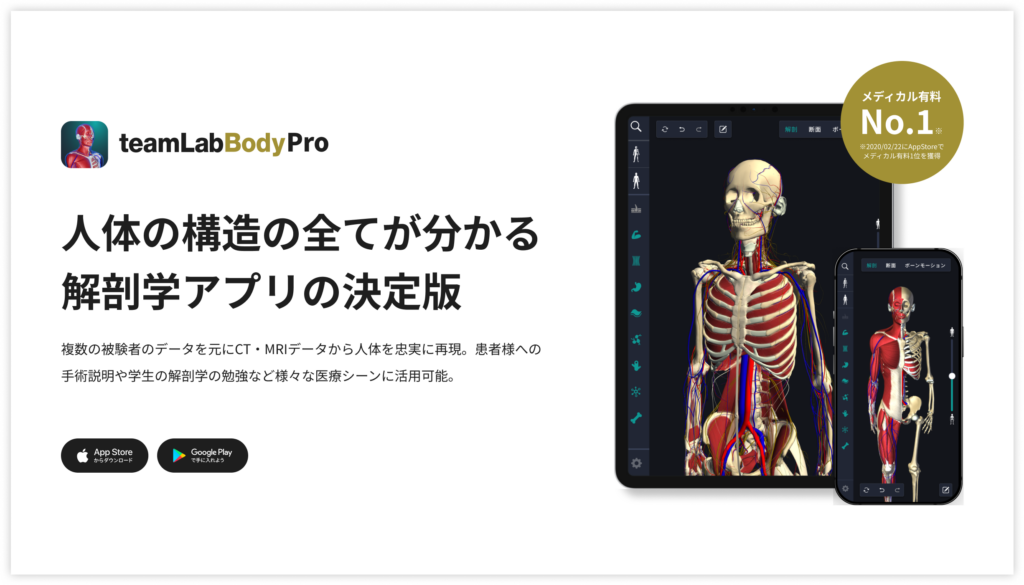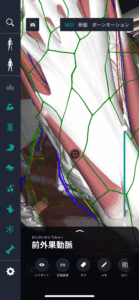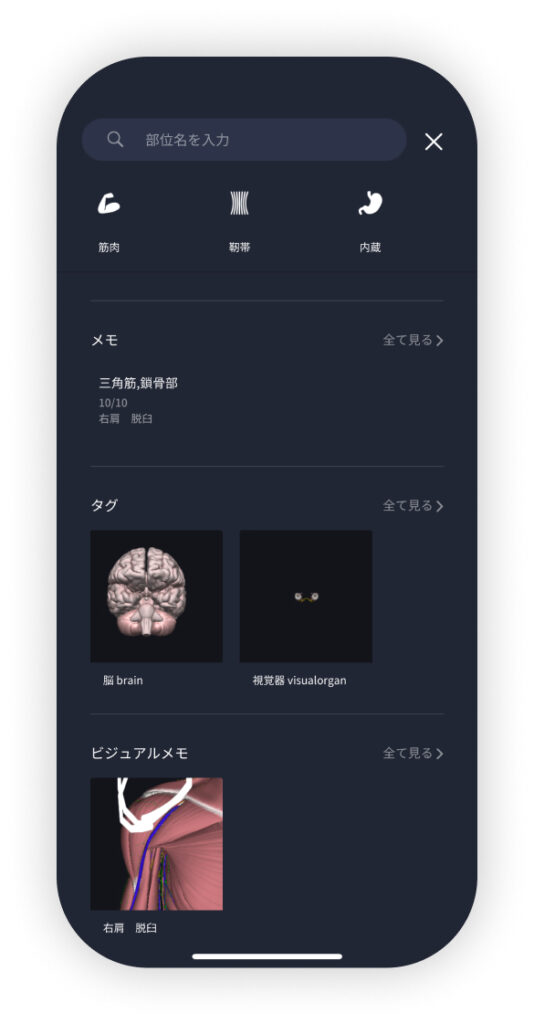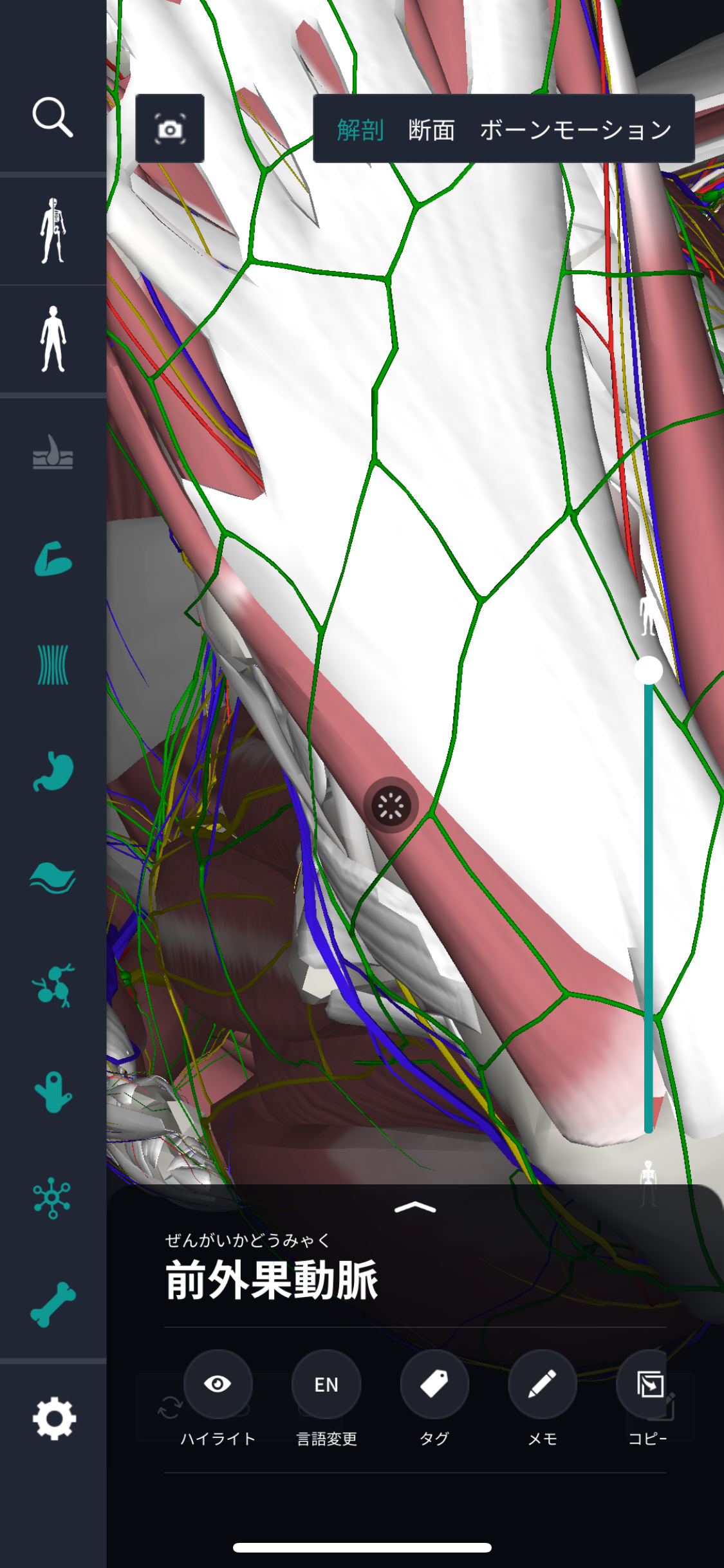beginning
In this article, I will explain effective study methods, starting with knowledge of specialized parts in human anatomy.
In human anatomy, it is necessary not only to memorize the names of various organs, muscles, and bones, but also to remember where they are located in the body. Therefore, it is necessary to learn as efficiently as possible.
I hope you can read this article and use the app to deepen your understanding even a little bit.
Now, I'll explain the details about the “anterior external fruit artery” and how to study human anatomy.
teamLab Body Pro Free Download
A 3D anatomy app that shows all the structures of the human body
Download teamLab Body Pro here!

What is the anterior external carotid artery?
In the anatomy application, you can view a selection of anatomy 3D models. In this model, there are various observation methods such as surfaces, cross-sections, and nervous systems. This time, I'll explain using an anatomy application.
About anterior external carotid artery

The anterior external carotid artery is one of the important blood vessels involved in the foot in the human body, and supplies blood from the outside of the lower leg to the outside of the foot. This artery branches from the common fibular artery and plays a role in sending blood flow mainly to the outer part of the ankle, specifically to the periphery. The anatomical position of the anterior external carotid artery is determined by its relationship with the fibula bone and surrounding muscles and soft tissue. The anterior external fruit artery is mainly closely related to important muscles such as triceps lower leg, fibula longus muscle, and short fibula muscle. These muscles have a major impact on how your ankles and feet move when walking or running. Therefore, insufficiency or damage to the anterior external arteries may affect these actions. Furthermore, due to its positional characteristics, the anterior external carotid artery is also a part that is easily affected during sports or trauma. In particular, trauma such as ankle sprains and fractures can cause compression and impaired blood circulation to this artery, leading to local ischemia and pain as a result. Therefore, evaluation and monitoring of the anterior external fruit artery has become an important issue in sports medicine and orthopedics. Medically, there is a risk that damage or blockage of this artery will lead to insufficient blood flow or ulcer formation in the foot, so quick and appropriate diagnosis and treatment is required. Also, diseases such as aneurysms and arteriosclerosis can also affect the anterior external carotid artery, and ultrasound and MRI are often used to diagnose them. Overall, the anterior external fruit artery is an important element that supports circulation in the lower leg and foot, and understanding its anatomy and function is essential for health management and surgical intervention.
Study points
Location and structure of anterior external carotid artery
The anterior external carotid artery functions as part of the path of the fibular artery that runs outside the lower leg, and is mainly located along the outer side of the external fruit, that is, the ankle. The fibular artery itself is closely related to the fibula muscle group, and the anterior external fruit artery has a role as its lower branch. This artery runs along the outside of the fibula and supplies oxygen and nutrients to the critical tissue layer on the outside of the ankle. Structurally, although this artery is relatively small, it exerts an important influence on the foot and surrounding soft tissue. The anterior external fruit artery path passes between muscle tissue such as gastrocnemius muscle, flap muscle, and fibula brevis muscle, etc., and ensures blood flow to target tissues and skin while branching and recombining just below the outer fruit. These structures are highly organized to maintain consistent blood circulation from the lower leg to the ankle to the outer tissues.
The role and function of the anterior external carotid artery
The role of the anterior external carotid artery is to supply necessary blood from the ankle to the outside of the foot and maintain the health of that tissue. In particular, by supporting blood flow, it enables continuous support during exercise or while standing. This artery carries oxygen and nutrients necessary for local metabolic activity, helps to excrete waste products, and plays a role in smoothing the metabolic process of tissues. Also, in cold winter environments or during prolonged exercise, circulation tends to decline in the periphery, and this artery also has a kind of thermoregulation (thermoregulation) effect by redistributing blood flow to regulate body temperature. Furthermore, the anterior external carotid artery promotes recovery from minor damage caused by sports and daily activities, and also plays a role in aiding cell repair. When blood flow is obstructed due to injury or illness, it is expected that these health maintenance functions will be restored by receiving appropriate diagnosis and treatment.
English notation for anterior external carotid artery
The English notation for anterior external carotid artery is “anterior lateral malleolar artery.” Each word that makes up this name has a specific anatomical meaning. The first “anterior” indicates “anterior” or “anterior,” and anatomically means that it is anterior to the midline. Next, “lateral” means “side,” indicating that it is located outside the center line of the body. This emphasizes that this artery runs outside of the lower leg or ankle. “Malleolar” is related to the “fruit part.” In particular, we are referring to a bone protrusion in the ankle called “malleolus” here. “Malleolus” is divided into two parts, an internal fruit and an external fruit, and the anterior external carotid artery is an artery that runs along the outer fruit of them. Finally, “Artery” means an artery, indicating that it is a blood vessel that carries oxygenated blood from the heart to tissues. Thus, each word “anabolic lateral malleolar artery” specifically expresses the location and function of an artery.
How to study human anatomy
I will explain specific study methods using human anatomy applications.
Check your past learning history and practice repeatedly
Here are the steps to check your anatomy learning history and practice iteratively effectively.
1. Check your learning history in the app
Reviewing your learning history with the application is an important step in effectively advancing anatomy learning. First, launch the app and go to the learning history section from the main menu. Many anatomy apps are designed to show your progress in the form of graphs and lists, so you can visually check which parts you've learned about and how much time you've spent.
By using this data, you can understand which areas you have strengths in and where you need to spend more time and effort. We also recommend using a dedicated tag or notebook function to mark areas you are particularly weak at or where you need to relearn. Regularly checking your learning history and looking back on past learning content will lead to efficient review and deepening understanding.
2.Make a plan for iterative learning
Making an efficient repetitive learning plan based on learning history is extremely effective in promoting knowledge retention. First, identify weak points and areas where you need to relearn. Next, arrange these study items into a weekly or monthly calendar and create a specific study schedule. By proceeding in a planned manner, you can learn each part evenly and avoid packing in a large amount of information at once.
Using a task management app or digital calendar to set study reminders is effective. Also, it's important to have the flexibility to regularly review progress and revise plans as needed. By having goals and proceeding with your studies in a planned manner, you can efficiently acquire anatomical knowledge.
3.Use 3D features to learn visually
By utilizing the 3D function, learning anatomy is easier to understand visually. The 3D model shows the structure of the human body three-dimensionally, and each part can be observed in detail. This makes it possible to intuitively grasp positional relationships between deep muscles and organs that are difficult to capture in a planar view. For example, you can learn even the smallest details by rotating specific muscles and bones and zooming in and out.
Also, there are many apps that have the function of displaying cross-sectional views of each part using a 3D model, which is useful for deepening understanding of internal structures. This diversity of visual information helps with memory retention and improves immediate responsiveness in tests and practice situations. By utilizing the 3D function and learning visually, you can learn anatomy knowledge more deeply and efficiently.
Use the memo function concretely

Make notes so you don't forget the things and points you've noticed while studying. The memo function can be used for different purposes, such as inputting text, saving images, and writing memos. Tag your notes to make them easier to review later.
Test your learning regularly in the form of quizzes
Regularly testing what you've learned in a quiz format is a very effective way to anchor your anatomy knowledge. Quiz-style tests help you objectively grasp your level of understanding and areas you lack while repeating knowledge.
For example, by using a learning app to conduct quizzes every specific period, you can reconfirm what you've learned and strengthen your memory. There are a wide range of quiz formats, such as multiple choice questions, fill-in-the-blank questions, and short answer questions, and each helps understanding from a different angle and develops the ability to utilize various types of knowledge.
Get feedback
If possible, get feedback from other learners and experts. It helps you find your own gaps in understanding and areas for improvement. You can also keep yourself motivated to learn by regularly testing yourself. Feeling a sense of accomplishment and progress increases motivation for continuous learning.
summary
This time, I explained how to study the “anterior external carotid artery” using an application!
Thank you for reading this far.
I would be happy if reading this article helped you learn about anatomy.
Learning is a long, never-ending journey, but I sincerely wish you all the best. Let's continue to study together and work hard for the national exam!
Please look forward to the next blog.




